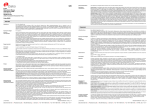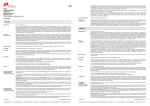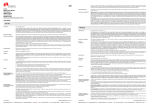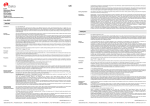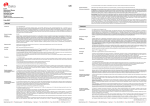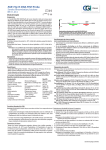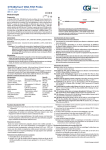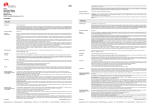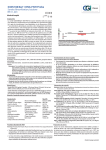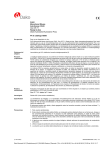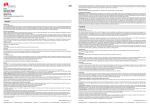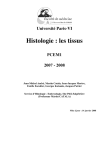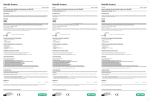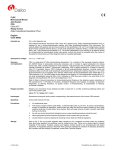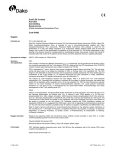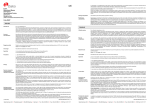Download FLEX Monoclonal Mouse Anti-Human CD43 Clone DF-T1
Transcript
Counterstaining in hematoxylin is recommended using EnVision FLEX Hematoxylin, (Dako Autostainer/Autostainer Plus) (Code K8018). Non-aqueous, permanent mounting medium is recommended. Positive and negative controls should be run simultaneously using the same protocol as the patient specimens. The positive control tissue should include tonsil and the cells/structures should display reaction patterns as described for this tissue in “Performance characteristics” in all positive specimens. The recommended negative control reagent is FLEX Negative Control, Mouse, (Dako Autostainer/Autostainer Plus) (Code IR750). FLEX Monoclonal Mouse Anti-Human CD43 Clone DF-T1 Ready-to-Use (Dako Autostainer/Autostainer Plus) Staining interpretation Cells labeled by the antibody display membranous staining. Performance characteristics Normal tissues: Most cells in the cortex and medulla of the thymus are strongly labeled. Analysis of 36 specimens with reactive plasma cells showed labeling of more than 1% of the plasma cells in 28% of the cases (6). In tonsil, the crowded T-cells in the T-zone show a strong staining reaction, whereas the isolated T-cells as well as the macrophages in the germinal centers show a moderate to strong staining reaction. Abnormal tissues: In haematolymphoid malignancies, 10/15 T-cell lymphomas were positive with the antibody. Of 20 B-cell lymphomas, 4/6 small lymphocytic, and 1/2 diffuse small cleaved cells (centrocytic) were positive, whereas all of 6 follicular, 2 diffuse large cell, and 2 hairy cell leukemias reacted negatively with the antibody (4). In meningiomas labeling of infiltrating T cells with the antibody has been reported in 29 of 34 cases (7). Immunohistochemical analysis of 51 cases of multiple myeloma (plasmacytoma) revealed positive labeling with the DF-T1 antibody in 59% of the cases (8). Downregulation of CD43 expression on most haematopoietic cells has been reported in 3 of 32 patients suffering from myelodysplastic syndrome (9). Code IS636 ENGLISH FRANÇAIS For in vitro diagnostic use. Intended use FLEX Monoclonal Mouse Anti-Human CD43, Clone DF-T1, Ready-to-Use, (Dako Autostainer/Autostainer Plus), is intended for use in immunohistochemistry together with Dako Autostainer/Autostainer Plus instruments. Antibodies against CD43 may be useful for the identification of lowgrade B-cell lymphomas, peripheral T-cell lymphomas and myeloid disorders (1). The clinical interpretation of any staining or its absence should be complemented by morphological studies using proper controls and should be evaluated within the context of the patient's clinical history and other diagnostic tests by a qualified pathologist. Synonyms for antigen Leukosialin, gpL115, sialophorin, leucocyte sialoglycoprotein (2). Summary and explanation Human CD43 is a single chain integral membrane protein with an apparent molecular weight between 95 000 and 135 000 (2). The mucin-like 234 amino acid extracellular domain is extensively glycosylated with 70-85 O-linked carbohydrate chains containing the sialyl-Lewis X epitope. Thus the molecule may act as a ligand for P- and E-selectin. Furthermore, the CD43 antigen may associate with intercellular adhesion molecule-1 (ICAM-1, CD54). The physiological understanding of the function of CD43 has been hindered by contradictory results, and so far data in support of the following functions has been provided; anti-adhesion, adhesion, signalling and cytoskeletal interaction (3). Pour utilisation lors d’un diagnostic in vitro. Utilisation prévu FLEX Monoclonal Mouse Anti-Human CD43, Clone DF-T1, Ready-to-Use, (Dako Autostainer/Autostainer Plus), est destiné à une utilisation en immunohistochimie avec les instruments Dako Autostainer/Autostainer Plus. Les anticorps anti-CD43 peuvent être utiles à l’identification de lymphomes B de faible malignité, de lymphomes T périphériques et de troubles de type myéloïde (1). L’interprétation clinique de toute coloration ou son absence doit être complétée par des études morphologiques en utilisant des contrôles appropriés et doit être évaluée en fonction des antécédents cliniques du patient et d’autres tests diagnostiques par un pathologiste qualifié. Synonymes de l’antigène Leucosialine, gpL115, sialophorine, sialoglycoprotéine de leucocyte (2). Résumé et explication Le CD43 humain est une protéine membranaire monocaténaire dont la masse moléculaire apparente se situe entre 95 000 et 135 000 (2). Le domaine extracellulaire de l’acide aminé 234 de type mucine est largement glycosylé par 70–85 chaînes d’hydrates de carbone, liées par les atomes d’oxygène, contenant l’épitope de type sialyl-Lewis X. Ainsi, la molécule peut agir comme ligand pour les sélectines P et E. De plus, l’antigène CD43 peut s’associer à la molécule d’adhésion intercellulaire 1 (ICAM-1, CD54). La compréhension de la fonction physiologique du CD43 a été gênée par des résultats contradictoires et, à ce jour, on a pu obtenir des données confirmant les fonctions suivantes : anti-adhésion, adhésion, signalisation et interaction au niveau du cytosquelette (3). CD43 is expressed, typically at high levels, on all leukocytes except most resting B lymphocytes. The expression on platelets is weak. CD43 is rapidly lost from lymphocyte and neutrophil surface by proteolytic shedding after activation with various stimuli (2). Although normal small B lymphocytes are negative for CD43, most low-grade B-cell lymphomas are positive. However, hairy cell leukaemia, MALT lymphoma, and follicle centre cell lymphomas are generally negative for CD43. Peripheral T-cell lymphomas are more often positive than negative. In a study of 28 extramedullary myeloid tumors, all were intensely positive for CD43, irrespective of the differentiation of the myeloid cells (1). Le CD43 est exprimé, généralement à des niveaux élevés, sur tous les leucocytes à l’exception de la plupart des lymphocytes B au repos. Son expression sur les plaquettes est faible. Après activation par des stimuli divers, le CD43 disparaît rapidement de la surface des lymphocytes et des neutrophiles par élimination protéolytique (2). Bien que les lymphocytes B normaux de petite taille soient négatifs au CD43, la plupart des lymphomes à lymphocytes B de faible malignité sont positifs. Cependant, les leucémies à tricoleucocytes, les lymphomes de MALT, ainsi que les lymphomes à cellules centro-folliculaires sont généralement négatifs au CD43. Les lymphomes T périphériques sont plus souvent positifs que négatifs. Dans une étude portant sur 28 tumeurs myéloïdes extra-médullaires, toutes étaient fortement positives au CD43, quel que soit le degré de différentiation des cellules myéloïdes (1). Refer to Dako’s General Instructions for Immunohistochemical Staining or the detection system instructions of IHC procedures for: 1) Principle of Procedure, 2) Materials Required, Not Supplied, 3) Storage, 4) Specimen Preparation, 5) Staining Procedure, 6) Quality Control, 7) Troubleshooting, 8) Interpretation of Staining, 9) General Limitations. Ready-to-use monoclonal mouse antibody provided in liquid form in a buffer containing stabilizing protein and 0.015 mol/L sodium azide. Reagent provided Se référer aux Instructions générales de coloration immunohistochimique de Dako ou aux instructions du système de détection relatives aux procédures IHC pour plus d’informations concernant les points suivants : 1) Principe de procédure, 2) Matériels requis mais non fournis, 3) Conservation, 4) Préparation des échantillons, 5) Procédure de coloration, 6) Contrôle qualité, 7) Dépannage, 8) Interprétation de la coloration, 9) Limites générales. Clone: DF-T1(4). Isotype: IgG1, kappa. Immunogen KG1 cells (myeloblastic cell line). Specificity Western blotting and immunohistochemical reactivity of the antibody is identical with that of CD43-clustered antibodies. Additionally the antibody reacts strongly with COS-7 cells (monkey kidney cell line) transfected with the CD43 gene, while control cells transfected with the vector only are negative (4). Anticorps monoclonal de souris prêt à l’emploi fourni sous forme liquide dans un tampon contenant une protéine stabilisante et 0,015 mol/L d’azide de sodium. Réactifs fournis Clone : DF-T1(4). Isotype : IgG1, kappa. The antibody causes rapid and vigorous aggregation among normal leucocytes and among T and myeloid/monocytic cell lines (5). 1. For professional users. 2. This product contains sodium azide (NaN3), a chemical highly toxic in pure form. At product concentrations, though not classified as hazardous, sodium azide may react with lead and copper plumbing to form highly explosive build-ups of metal azides. Upon disposal, flush with large volumes of water to prevent metal azide build-up in plumbing. 3. As with any product derived from biological sources, proper handling procedures should be used. 4. Wear appropriate Personal Protective Equipment to avoid contact with eyes and skin. 5. Unused solution should be disposed of according to local, State and Federal regulations. Precautions Storage Store at 2-8 °C. Do not use after expiration date sta mped on vial. If reagents are stored under any conditions other than those specified, the conditions must be verified by the user. There are no obvious signs to indicate instability of this product. Therefore, positive and negative controls should be run simultaneously with patient specimens. If unexpected staining is observed which cannot be explained by variations in laboratory procedures and a problem with the antibody is suspected, contact Dako Technical Support. Specimen preparation including materials required but not supplied The antibody can be used for labeling formalin-fixed, paraffin-embedded tissue sections. Tissue specimens should be cut into sections of approximately 4 µm. Pre-treatment with heat-induced epitope retrieval (HIER) is required using Dako PT Link (Code PT100/PT101). For details, please refer to the PT Link User Guide. Optimal results are obtained by pretreating tissues using EnVision FLEX Target Retrieval Solution, High pH (50x) (Code K8010/K8004). Immunogène Cellules KG1 (lignée cellulaire myéloblastique) Spécificité Le résultat du test Western blot et la réactivité immunohistochimique de l’anticorps sont identiques aux anticorps anti-CD43. En outre, l’anticorps réagit fortement aux cellules COS-7 (lignée cellulaire rénale de singe) transfectées avec le gène du CD43, alors que les cellules de contrôle transfectées uniquement avec le vecteur sont négatives (4). Cet anticorps entraîne une agrégation rapide et forte des leucocytes normaux d’une part et des lignées cellulaires myéloïdes/monocytaires et T, d’autre part (5). Précautions 1. Pour utilisateurs professionnels. 2. Ce produit contient de l’azide de sodium (NaN3), produit chimique hautement toxique dans sa forme pure. Aux concentrations du produit, bien que non classé comme dangereux, l’azide de sodium peut réagir avec le cuivre et le plomb des canalisations et former des accumulations d’azides métalliques hautement explosifs. Lors de l’élimination, rincer abondamment à l’eau pour éviter toute accumulation d’azide métallique dans les canalisations. 3. Comme avec tout produit d’origine biologique, des procédures de manipulation appropriées doivent être respectées. 4. Porter un vêtement de protection approprié pour éviter le contact avec les yeux et la peau. 5. Les solutions non utilisées doivent être éliminées conformément aux réglementations locales et nationales. Conservation Conserver entre 2 et 8 °C. Ne pas utiliser après la date de péremption indiquée sur le flacon. Si les réactifs sont conservés dans des conditions autres que celles indiquées, celles-ci doivent être validées par l’utilisateur. Il n’y a aucun signe évident indiquant l’instabilité de ce produit. Par conséquent, des contrôles positifs et négatifs doivent être testés en même temps que les échantillons de patient. Si une coloration inattendue est observée, qui ne peut être expliquée par un changement des procédures du laboratoire, et en cas de suspicion d’un problème lié à l’anticorps, contacter l’assistance technique de Dako. Préparation des échantillons y compris le matériel requis mais non fourni L’anticorps peut être utilisé pour le marquage des coupes de tissus inclus en paraffine et fixés au formol. L’épaisseur des coupes d’échantillons de tissu doit être d’environ 4 µm. Paraffin-embedded sections: Pre-treatment of formalin-fixed, paraffin-embedded tissue sections is recommended using the 3-in-1 specimen preparation procedure for Dako PT Link. Follow the pre-treatment procedure outlined in the package insert for EnVision FLEX Target Retrieval Solution, High pH (50x) (Code K8010/K8004). Note: After staining the sections must be dehydrated, cleared and mounted using permanent mounting medium. Deparaffinized sections: Pre-treatment of deparaffinized formalin-fixed, paraffin-embedded tissue sections is recommended using Dako PT Link and following the same procedure as described for paraffin-embedded sections. After staining the slides should be mounted using aqueous or permanent mounting medium. The tissue sections should not dry out during the treatment or during the following immunohistochemical staining procedure. For greater adherence of tissue sections to glass slides, the use of FLEX IHC Microscope Slides (Code K8020) is recommended. Staining procedure including materials required but not supplied Coupes incluses en paraffine : le prétraitement des coupes tissulaires fixées au formol et incluses en paraffine est recommandé à l'aide de la procédure de préparation d'échantillon 3-en-un pour le Dako PT Link. Suivre la procédure de prétraitement indiquée dans la notice de la EnVision FLEX Target Retrieval Solution, High pH (50x) (Réf. K8010/K8004). Remarque : après coloration, les coupes doivent être déshydratées, lavées et montées à l’aide d’un milieu de montage permanent. The recommended visualization system is EnVision FLEX, High pH, (Dako Autostainer/Autostainer Plus) (Code K8010). The staining steps and incubation times are pre-programmed into the software of Dako Autostainer/Autostainer Plus instruments, using the following protocols: Template protocol: FLEXRTU2 (200 µL dispense volume) or FLEXRTU3 (300 µL dispense volume) Coupes déparaffinées : le prétraitement des coupes tissulaires déparaffinées, fixées au formol et incluses en paraffine, est recommandé à l’aide du Dako PT Link, en suivant la même procédure que pour les coupes incluses en paraffine. Après coloration, un montage aqueux ou permanent des lames est recommandé. Autoprogram: CD43 (without counterstaining) or CD43H (with counterstaining) The Auxiliary step should be set to “rinse buffer” in staining runs with ≤10 slides. For staining runs with >10 slides the Auxiliary step should be set to “none”. This ascertains comparable wash times. Les coupes de tissus ne doivent pas sécher lors du traitement ni lors de la procédure de coloration immunohistochimique suivante. Pour une meilleure adhérence des coupes de tissus sur les lames de verre, il est recommandé d’utiliser des lames FLEX IHC Microscope Slides (Réf. K8020). All incubation steps should be performed at room temperature. For details, please refer to the Operator’s Manual for the dedicated instrument. If the protocols are not available on the used Dako Autostainer instrument, please contact Dako Technical Services. Optimal conditions may vary depending on specimen and preparation methods, and should be determined by each individual laboratory. If the evaluating pathologist should desire a different staining intensity, a Dako Application Specialist/Technical Service Specialist can be contacted for information on reprogramming of the protocol. Verify that the performance of the adjusted protocol is still valid by evaluating that the staining pattern is identical to the staining pattern described in “Performance characteristics”. (117325-003) Dako Denmark A/S IS636/EFG/MNI/2009.12.04 p. 1/4 | Produktionsvej 42 | DK-2600 Glostrup | Denmark | Tel. +45 44 85 95 00 | Fax +45 44 85 95 95 | CVR No. 33 21 13 17 Un prétraitement avec démasquage d’épitope induit par la chaleur (HIER) est nécessaire avec le Dako PT Link (Réf. PT100/PT101). Pour plus de détails, se référer au Guide d’utilisation du PT Link. Des résultats optimaux sont obtenus en prétraitant les tissus à l’aide de la EnVision FLEX Target Retrieval Solution, High pH (50x) (Réf. K8010/K8004). Procédure de coloration y compris le matériel requis mais non fourni (117325-003) Dako Denmark A/S Le système de visualisation recommandé est le EnVision FLEX, High pH, (Dako Autostainer/Autostainer Plus) (Code K8010). Les étapes de coloration et les temps d’incubation sont préprogrammés dans le logiciel des instruments Dako Autostainer/Autostainer Plus, à l’aide des protocoles suivants : Protocole modèle : FLEXRTU2 (volume d’application de 200 µL) ou FLEXRTU3 (volume d’application de 300 µL) Programme automatique : CD43 (sans contre-coloration) ou CD43H (avec contre-coloration). IS636/EFG/MNI/2009.12.04 p. 2/4 | Produktionsvej 42 | DK-2600 Glostrup | Denmark | Tel. +45 44 85 95 00 | Fax +45 44 85 95 95 | CVR No. 33 21 13 17 L’étape Auxiliary doit être réglée sur « rinse buffer » lors des cycles de coloration avec ≤10 lames. Pour les cycles de coloration de >10 lames, l’étape Auxiliary doit être réglée sur « none ». Cela confirme des temps de lavage comparables. (50x) (Code-Nr. K8010/K8004) durchführen. Hinweis: Nach dem Färben müssen die Schnitte dehydriert, geklärt und mit permanentem Einbettmedium auf den Objektträger aufgebracht werden. Toutes les étapes d’incubation doivent être effectuées à température ambiante. Pour plus de détails, se référer au Manuel de l’opérateur spécifique à l'instrument. Si les protocoles ne sont pas disponibles sur l’instrument Dako Autostainer utilisé, contacter le service technique de Dako. Entparaffinierte Schnitte: Eine Vorbehandlung der entparaffinierten, formalinfixierten, paraffineingebetteten Gewebeschnitte mit Dako PT Link nach demselben Verfahren, wie für die paraffineingebetteten Schnitte beschrieben, wird empfohlen. Die Objektträger nach dem Färben mit einem wässrigen oder permanenten Einbettmedium bedecken. Les conditions optimales peuvent varier en fonction du prélèvement et des méthodes de préparation, et doivent être déterminées par chaque laboratoire individuellement. Si le pathologiste qui réalise l’évaluation désire une intensité de coloration différente, un spécialiste d’application/spécialiste du service technique de Dako peut être contacté pour obtenir des informations sur la re-programmation du protocole. Vérifier que l’exécution du protocole modifié est toujours valide en vérifiant que le schéma de coloration est identique au schéma de coloration décrit dans les « Caractéristiques de performance ». Die Gewebeschnitte dürfen während der Behandlung oder des anschließenden immunhistochemischen Färbeverfahrens nicht austrocknen. Zur besseren Haftung der Gewebeschnitte an den Glasobjektträgern wird die Verwendung von FLEX IHC Microscope Slides (Code-Nr. K8020) empfohlen. Färbeverfahren und erforderliche, aber nicht mitgelieferte Materialien Il est recommandé d’effectuer une contre-coloration à l’aide d’hématoxyline EnVision FLEX Hematoxylin, (Dako Autostainer/Autostainer Plus) (Réf. K8018). L’utilisation d’un milieu de montage permanent non aqueux est recommandée. Des contrôles positifs et négatifs doivent être réalisés en même temps et avec le même protocole que les échantillons du patient. Le contrôle de tissu positif doit comprendre l’amygdale et les cellules/structures doivent présenter les schémas de réaction décrits pour ces tissus dans les « Caractéristiques de performance » pour tous les échantillons positifs. Le contrôle négatif recommandé est le FLEX Negative Control, Mouse, (Dako Autostainer/Autostainer Plus) (Réf. IR750). Les cellules marquées par l’anticorps présentent une coloration membranaire. Caractéristiques de performance Tissus sains : la plupart des cellules du cortex et de la medulla du thymus sont fortement marquées. L’analyse de 36 échantillons comportant des cellules plasmatiques réactives a présenté un marquage de plus de 1 % de ces cellules dans 28 % des cas (6). Dans l’amygdale, les amas de lymphocytes T dans la zone T présentent une forte coloration alors que les lymphocytes T isolés ainsi que les macrophages dans les centres germinatifs présentent une coloration modérée à forte. Bei Färbedurchläufen mit höchstens 10 Objektträgern sollte der Zusatz-Schritt auf „Pufferspülgang“ eingestellt werden. Für Färbedurchläufe mit mehr als 10 Objektträgern den Zusatz-Schritt auf „Keine“ einstellen. Dies gewährleistet vergleichbare Waschzeiten. Die optimalen Bedingungen können sich je nach Probe und Präparationsverfahren unterscheiden und sollten vom jeweiligen Labor selbst ermittelt werden. Falls der beurteilende Pathologe eine andere Färbungsintensität wünscht, kann ein Anwendungsspezialist oder Kundendiensttechniker von Dako bei der Neuprogrammierung des Protokolls helfen. Die Leistung des angepassten Protokolls muss verifiziert werden, indem gewährleistet wird, dass das Färbemuster mit dem unter „Leistungsmerkmale“ beschriebenen Färbemuster identisch ist. Die Gegenfärbung in Hämatoxylin sollte mit EnVision FLEX Hematoxylin (Dako Autostainer/Autostainer Plus) (Code-Nr. K8018) ausgeführt werden. Empfohlen wird ein nichtwässriges, permanentes Fixiermittel. Tissus tumoraux : dans les tumeurs malignes hématolymphoïdes, 10 cas de lymphomes à lymphocytes T sur 15 se sont avérés positifs à l’anticorps. Sur 20 lymphomes B, 4 lymphomes lymphocytaires à petites cellules sur 6, et 1 des 2 lymphomes diffus à petites cellules clivées (centrocytiques) étaient positifs, alors que les 6 leucémies folliculaires, les 2 leucémies diffuses à grandes cellules et les 2 leucémies à tricoleucocytes ont réagi de manière négative à l’anticorps (4). Dans les méningiomes, le marquage des lymphocytes T infiltrants par l’anticorps a été observé dans 29 cas sur 34 (7). L’analyse immunohistochimique de 51 cas de myélomes multiples (plasmacytome) a révélé un marquage positif par l’anticorps anti-DF-T1 dans 59 % des cas (8). Une régulation à la baisse de l’expression du CD43 sur la plupart des cellules hématopoïétiques a été signalée chez 3 des 32 patients souffrant d’un syndrome myélodysplasique (9). Positiv- und Negativkontrollen sollten parallel zu den Patientenproben und nach demselben Protokoll angefärbt werden. Als positive Kontrolle sollte Mandelgewebe verwendet werden, und die Zellen/Strukturen müssen in allen positiven Proben die unter „Leistungsmerkmale“ für dieses Gewebe beschriebenen Reaktionsmuster aufweisen. Das empfohlene Negativ-Kontrollreagenz ist FLEX Negative Control, Mouse, (Dako Autostainer/Autostainer Plus) (Code-Nr. IR750). DEUTSCH Auswertung der Färbung Mit dem Antikörper markierte Zellen weisen eine Membranfärbung auf. Leistungsmerkmale Gesundes Gewebe: Zellen in Kortex und Medulla des Thymus werden zumeist stark markiert. Bei der Untersuchung von 36 Proben mit reaktiven Plasmazellen wiesen in 28 % der Fälle mehr als 1 % der Plasmazellen eine Markierung auf (6). In den Mandeln zeigten die zusammengedrängten TZellen in der T-Zone eine starke Färbung, wogegen die isolierten T-Zellen und die Makrophagen in den Keimzentren eine mäßige bis starke Färbung aufwiesen. Zur In-vitro-Diagnostik. Pathologisches Gewebe: Bei hämatolymphoiden Tumoren reagierten 10 von 15 der T-Zell-Lymphome mit dem Antikörper. Von 20 B-Zell-Lymphomen waren 4 von 6 vom kleinzelligen lymphozytischen Typ und 1 von 2 vom diffus kleinzellig gespaltenen Typ (Zentrozyten-Lymphom) positiv, alle 6 follikulären, 2 diffus großzellige und 2 Haarzellenleukämien dagegen waren negativ (4). Bei Meningiomen wurden infiltrierende T-Zellen in 29 der 34 Fälle mit dem Antikörper markiert (7). Bei der immunohistochemischen Analyse von 51 Fällen von multiplem Myelom (Plasmazytom) wurde in 59 % der Fälle eine positive Markierung mit dem DF-T1 Antikörper beobachtet (8). Bei 3 von 32 Patienten mit Myelodysplasiesyndrom wurde auf den meisten hämatopoetischen Zellen eine erniedrigte CD43-Expression beobachtet (9). FLEX Monoclonal Mouse Anti-Human CD43, Clone DF-T1, Ready-to-Use, (Dako Autostainer/Autostainer Plus), ist zur Verwendung in der Immunhistochemie in Verbindung mit Dako Autostainer/Autostainer Plus-Geräten bestimmt. Antikörper gegen CD43 können beim Nachweis von schwach ausgeprägten B-Zelllymphomen, peripheren T-Zelllymphomen und myeloiden Störungen behilflich sein (1). Die klinische Auswertung einer eventuell eintretenden Färbung sollte durch morphologische Untersuchung mit geeigneten Kontrollen ergänzt und von einem qualifizierten Pathologen unter Berücksichtigung der Krankengeschichte des Patienten und anderer diagnostischer Tests vorgenommen werden. Synonyme für das Antigen Leukosialin, gpL115, Sialophorin, Leukozyten-Sialoglycoprotein (2). Zusammenfassung und Erklärung Menschliches CD43 ist ein einkettiges integrales Membranprotein mit einem scheinbaren Molekulargewicht zwischen 95 000 und 135 000 (2). Die muzinartige, 234 Aminosäuren lange extrazelluläre Domäne ist mit 70–85 O-gebundenen Kohlenhydratketten, die das Sialyl-Lewis-X-Epitop enthalten, stark glykosyliert. Dadurch kann das Molekül als Ligand für P- und E-Selektin agieren. Darüber hinaus kann sich das CD43-Antigen mit dem interzellulären Adhäsionsmolekül-1 (ICAM-1, CD54) assoziieren. Das Verständnis der physiologischen Funktion von CD43 wurde durch einander widersprechende Forschungsergebnisse erschwert. Die bisher vorliegenden Daten weisen auf folgende Funktionen hin: Anti-Adhäsion, Adhäsion, Signalübertragung und Zytoskelett-Interaktion (3). Geliefertes Reagenz Matrix-Protokoll: FLEXRTU2 (200 µl Anwendungsvolumen) oder FLEXRTU3 (300 µl Anwendungsvolumen) Autoprogramm: CD43 (ohne Gegenfärbung) oder CD43H (mit Gegenfärbung) Alle Inkubationsschritte bei Raumtemperatur durchführen. Nähere Einzelheiten bitte dem Benutzerhandbuch für das jeweilige Gerät entnehmen. Wenn die Färbeprotokolle auf dem verwendeten Dako Autostainer-Gerät nicht verfügbar sind, bitte den Technischen Kundendienst von Dako verständigen. Interprétation de la coloration Verwendungszweck Das empfohlene Visualisierungssystem ist EnVision FLEX+, High pH, (Dako Autostainer/Autostainer Plus) (Code-Nr. K8010). Die Färbeschritte und Inkubationszeiten sind in der Software der Dako Autostainer/Autostainer Plus-Geräte mit den folgenden Protokollen vorprogrammiert: References/ Références/ Literatur 1. Leong A, Cooper K, Leong F. Manual of diagnostic antibodies for immunohistology. 2nd edition. Greenwich Medical Media 2003. p. 167-170 2. Horejsi V. CD guide. CD43. In: Mason D, André P, Bensussan A, Buckley C, Civin C, Clark E, et al., editors. Leucocyte typing VII. White cell differentiation antigens. Proceedings of the 7th International Workshop and Conference; 2000 Jun 19-23; Harrogate, United Kingdom. New York: Oxford University Press Inc.; 2002. p. 790-1. 3. Ostberg JR, Barth RK, Frelinger JG. The Roman god Janus: a paradigm for the function of CD43. Immunology Today 1998;19:546-50. CD43 wird, in der Regel mit hohen Expressionsniveaus, auf allen Leukozyten mit Ausnahme der ruhenden B-Lymphozyten exprimiert. Auf Thrombozyten ist die Expression schwach. CD43 löst sich nach Aktivierung durch verschiedene Stimuli schnell infolge von proteolytischer Abspaltung von Lymphozyten- und Neutrophilenoberflächen (2). Zwar sind normale kleine B-Lymphozyten negativ für CD43, die meisten schwach ausgeprägten B-ZellLymphome sind jedoch positiv. Haarzellenleukämie, MALT-Lymphome sowie Follikelzentrum-Lymphome sind jedoch in der Regel CD43-negativ. Periphere T-Zelllymphome sind öfter positiv als negativ. In einer Studie an 28 extramedullären myeloiden Tumoren reagierten alle untersuchten Proben stark positiv auf CD43, unabhängig vom Differenzierungsgrad der myeloischen Zellen (1). 4. Stross WP, Warnke RA, Flavell DJ, Flavell SU, Simmons D, Gatter KC, et al. Molecule detected in formalin fixed tissue by antibodies MT1, DF-T1, and L60 (Leu-22) corresponds to CD43 antigen. J Clin Pathol 1989;42:953-61. 1. 5. de Smet W, Walter H, van Hove L. A new CD43 monoclonal antibody induces homotypic aggregation of human leucocytes through a CD11a/CD18-dependent and -independent mechanism. Immunology 1993;79:46-54. 6. Beschorner R, Horny HP, Petruch UR, Kaiserling E. Frequent expression of haemopoietic and non-haemopoietic antigens by reactive plasma cells: an immunohistochemical study using formalin-fixed, paraffin-embedded tissue. Histol Histopathol 1999;14:805-12. Folgende Angaben bitte den Allgemeinen Richtlinien zur immunhistochemischen Färbung von Dako oder der Gebrauchsanweisung für das jeweilige IHCDetektionsverfahren entnehmen: 1) Verfahrensprinzip, 2) Erforderliche, aber nicht mitgelieferte Materialien, 3) Aufbewahrung, 4) Vorbereitung der Proben, 5) Färbeverfahren, 6) Qualitätskontrolle, 7) Fehlersuche und -behebung, 8) Auswertung der Färbung, 9) Allgemeine Beschränkungen. 7. Bø L, Mørk SJ, Nyland H. An immunohistochemical study of monuclear cells in meningiomas. Neuropathol Appl Neurobiol 1992;18:548-58. 8. Petruch UR, Horny HP, Kaiserling E. Frequent expression of haemopoietic and non-haemopoietic antigens by neoplastic plasma cells: an immunohistochemical study using formalinfixed, paraffin-embedded tissues. Histopathology 1992;20:35-40. Gebrauchsfertiger monoklonaler Maus-Antikörper, gelöst in einem Puffer, der Stabilisierungsprotein und 0,015 mol/L Natriumazid enthält. 9. Kyriakou DS, Alexandrakis M, Tzardi M, Stephanaki D, Eliopoulos GD. Downregulation of CD43 in RAEB and RAEB-T patients. Report of 3 cases. Am J Hematol 2000;63:20-7. Klon: DF-T1(4). Isotyp: IgG1, Kappa. Immunogen KG1-Zellen (myeloblastische Zelllinie). Spezifität Die Reaktivität des Antikörpers im Western-Blot bzw. bei immunzytochemischen Verfahren entspricht derjenigen geclusterter CD43-Antikörper. Darüber hinaus reagiert der Antikörper stark mit COS-7-Zellen (Nierenzelllinie des Affen), die mit dem CD43-Gen transfiziert wurden; nur mit dem Vektor transfizierte Kontrollzellen dagegen sind negativ (4). Explanation of symbols/ Explication des symboles/ Erläuterung der Symbole Der Antikörper führt bei normalen Leukozyten sowie bei T-Zellen und myeloischen/monozytischen Zelllinien zur schnellen und heftigen Zellaggregatbildung (5). 1. Nur für Fachpersonal bestimmt. 2. Dieses Produkt enthält Natriumazid (NaN3), eine in reiner Form äußerst giftige Chemikalie. Natriumazid kann auch in als ungefährlich eingestuften Konzentrationen mit Blei- und Kupferrohren reagieren und hochexplosive Metallazide bilden. Nach der Entsorgung stets mit viel Wasser nachspülen, um Metallazidansammlungen in den Leitungen vorzubeugen. 3. Wie alle Produkte biologischen Ursprungs müssen auch diese entsprechend gehandhabt werden. 4. Geeignete Schutzkleidung tragen, um Augen- und Hautkontakt zu vermeiden. 5. Nicht verwendete Lösung ist entsprechend örtlichen, bundesstaatlichen und staatlichen Richtlinien zu entsorgen. Vorsichtsmaßnahmen Lagerung Bei 2–8 °C aufbewahren. Nach Ablauf des auf dem Fläschch en aufgedruckten Verfalldatums nicht mehr verwenden. Werden die Reagenzien unter anderen als den angegebenen Bedingungen aufbewahrt, müssen diese Bedingungen vom Benutzer validiert werden. Es gibt keine offensichtlichen Anzeichen für eine eventuelle Produktinstabilität. Positiv- und Negativkontrollen sollten daher zur gleichen Zeit wie die Patientenproben getestet werden. Falls es zu einer unerwarteten Färbung kommt, die sich nicht durch Unterschiede bei Laborverfahren erklären lässt und auf ein Problem mit dem Antikörper hindeutet, ist der technische Kundendienst von Dako zu verständigen. Vorbereitung der Probe und erforderliche, aber nicht mitgelieferte Materialien Der Antikörper eignet sich zur Markierung von formalinfixierten und paraffineingebetteten Gewebeschnitten. Gewebeproben sollten in Schnitte von ca. 4 µm Stärke geschnitten werden. Catalogue number Référence catalogue Bestellnummer Temperature limitation Limites de température Zulässiger Temperaturbereich Use by Utiliser avant Verwendbar bis In vitro diagnostic medical device Dispositif médical de diagnostic in vitro In-vitro-Diagnostikum Contains sufficient for <n> tests Contenu suffisant pour <n> tests Inhalt ausreichend für <n> Tests Manufacturer Fabricant Hersteller Consult instructions for use Voir les instructions d’utilisation Gebrauchsanweisung beachten Batch code Numéro de lot Chargenbezeichnung Die Vorbehandlung durch hitzeinduzierte Epitopdemaskierung (HIER) mit Dako PT Link (Code-Nr. PT100/PT101) ist erforderlich. Weitere Informationen hierzu siehe PT Link-Benutzerhandbuch. Optimale Ergebnisse können durch Vorbehandlung der Gewebe mit EnVision FLEX Target Retrieval Solution, High pH (50x) (Code-Nr. K8010/K8004) erzielt werden. Paraffineingebettete Schnitte: Die Vorbehandlung der formalinfixierten, paraffineingebetteten Schnitte mit dem 3-in-1-Probenvorbereitungsverfahren für Dako PT Link wird empfohlen. Vorbehandlung gemäß der Beschreibung in der Packungsbeilage für EnVision FLEX Target Retrieval Solution, High pH (117325-003) Dako Denmark A/S IS636/EFG/MNI/2009.12.04 p. 3/4 | Produktionsvej 42 | DK-2600 Glostrup | Denmark | Tel. +45 44 85 95 00 | Fax +45 44 85 95 95 | CVR No. 33 21 13 17 (117325-003) Dako Denmark A/S IS636/EFG/MNI/2009.12.04 p. 4/4 | Produktionsvej 42 | DK-2600 Glostrup | Denmark | Tel. +45 44 85 95 00 | Fax +45 44 85 95 95 | CVR No. 33 21 13 17


